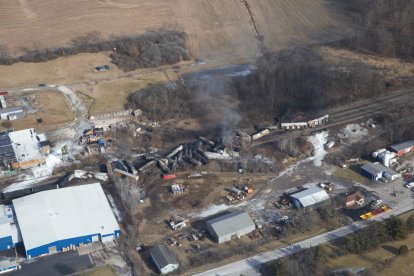NTSB report on East Palestine derailment points to overheated wheel bearing
The release of the National Transportation Safety Board's preliminary findings coincides with the Secretary of Transportation's visit to Ohio, 20 days after the toxic spill.

(Wikimedia Commons)
Federal investigators released the preliminary report Thursday on the derailment of a Norfolk Southern train carrying toxic chemicals in East Palestine, Ohio, earlier this month.
Preliminary findings by the National Transportation Safety Board (NTSB) reveal that one of the train's wheel bearings heated up to 253 degrees Fahrenheit above ambient temperature. Specifically, the report notes that "surveillance video from a local residence showed what appeared to be a wheel bearing in the final stage of overheat failure moments before the derailment. The wheel bearing and affected wheelset have been collected as evidence and will be examined by the NTSB."
The NTSB recalled that, at the time of the accident, visibility conditions were cloudy and clear and the weather was 10°F with no precipitation. The report states that the train was traveling at a speed of approximately 47 mph, below the maximum authorized speed of 50 mph. The positive train control system was activated and operational at the time of the derailment.
The key to the preliminary report is "overheat failure." According to the preliminary report, the wheel bearing passed through three sensors before the derailment. Each time it happened, the temperature was higher. The third and final sensor recorded a temperature of 253 degrees. A critical audible alarm message was transmitted instructing the crew to reduce speed and stop the train to inspect a hot axle. The engineer increased the application of the dynamic brake application to slow and eventually stop the train. During this deceleration, an automatic emergency brake was initiated and the train derailed.
The preliminary report of the National Transportation Safety Board is available here
RRD23MR005 East Palestine O... by VozMedia
Among the derailed cars were several tank cars carrying hazardous materials that caught fire and damaged other cars that were not derailed. First responders established a one-mile evacuation zone around the derailment site that affected about 2,000 residents. There were no fatalities or injuries, but there was a toxic cloud with potentially fatal and still unpredictable consequences.
According to the NTSB, 38 cars were derailed in the accident. Eleven of those railcars contained hazardous materials, five of them contained vinyl chloride, a highly volatile colorless gas produced for commercial uses.
The report was released 20 days after the derailment and coincided with Secretary of Transportation Pete Buttigieg's visit to East Palastine, which came after almost three weeks of harsh criticism, first for concealing the incident and later for the federal administration's neglect to step in and help the affected area of Ohio.
RECOMMENDATION





















